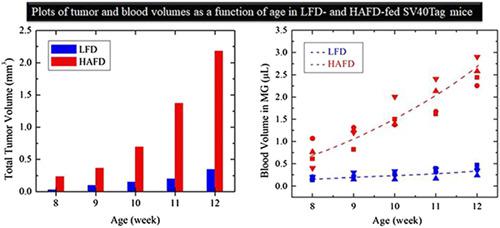当前位置:
X-MOL 学术
›
NMR Biomed.
›
论文详情
Our official English website, www.x-mol.net, welcomes your feedback! (Note: you will need to create a separate account there.)
Magnetic resonance angiography reveals increased arterial blood supply and tumorigenesis following high fat feeding in a mouse model of triple-negative breast cancer.
NMR in Biomedicine ( IF 2.9 ) Pub Date : 2020-08-05 , DOI: 10.1002/nbm.4363 Devkumar Mustafi 1 , Rebecca Valek 1 , Michael Fitch 1 , Victoria Werner 1 , Xiaobing Fan 1 , Erica Markiewicz 1 , Sully Fernandez 2 , Marta Zamora 1 , Jeffrey Mueller 3 , Olufunmilayo I Olopade 4 , Suzanne D Conzen 4 , Matthew J Brady 2 , Gregory S Karczmar 1
NMR in Biomedicine ( IF 2.9 ) Pub Date : 2020-08-05 , DOI: 10.1002/nbm.4363 Devkumar Mustafi 1 , Rebecca Valek 1 , Michael Fitch 1 , Victoria Werner 1 , Xiaobing Fan 1 , Erica Markiewicz 1 , Sully Fernandez 2 , Marta Zamora 1 , Jeffrey Mueller 3 , Olufunmilayo I Olopade 4 , Suzanne D Conzen 4 , Matthew J Brady 2 , Gregory S Karczmar 1
Affiliation

|
Breast cancer is the second most commonly diagnosed malignancy among women globally. Past MRI studies have linked a high animal fat diet (HAFD) to increased mammary cancer risk in the SV40Tag mouse model of triple‐negative breast cancer. Here, serial MRI examines tumor progression and measures the arterial blood volume feeding mammary glands in low fat diet (LFD) or HAFD fed mice.
中文翻译:

磁共振血管造影显示在三阴性乳腺癌小鼠模型中高脂肪喂养后动脉血供增加和肿瘤发生。
乳腺癌是全球女性中第二大最常见的恶性肿瘤。过去的 MRI 研究已经将高动物脂肪饮食 (HAFD) 与三阴性乳腺癌 SV40Tag 小鼠模型中乳腺癌风险的增加联系起来。在这里,连续 MRI 检查肿瘤进展并测量低脂饮食 (LFD) 或 HAFD 喂养小鼠乳腺的动脉血容量。
更新日期:2020-09-03
中文翻译:

磁共振血管造影显示在三阴性乳腺癌小鼠模型中高脂肪喂养后动脉血供增加和肿瘤发生。
乳腺癌是全球女性中第二大最常见的恶性肿瘤。过去的 MRI 研究已经将高动物脂肪饮食 (HAFD) 与三阴性乳腺癌 SV40Tag 小鼠模型中乳腺癌风险的增加联系起来。在这里,连续 MRI 检查肿瘤进展并测量低脂饮食 (LFD) 或 HAFD 喂养小鼠乳腺的动脉血容量。



























 京公网安备 11010802027423号
京公网安备 11010802027423号